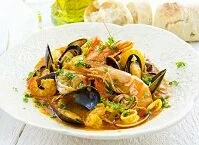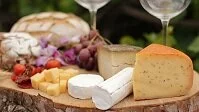Dining Etiquette

Bouillabaisse
Punctuality in France is defined quite differently from many northern European and North American countries, but when dining at a local's home, you should arrive close to the time agreed upon. It is common in France to arrive about 10-15 minutes late, but when it comes to food, most people arrive closer to 5-10 minutes late.
You can take that extra time to second guess your dress or get a gift for your host, but don't get wine unless it's a local wine, since most French known their wines and you don't want to insult them with a poor quality bottle. As a fashion capital, dressing nicely and in something unique and fashionably is expected so be careful with what you wear.
Once you begin eating, the atmosphere is fairly relaxed and very social. Wine is commonly served with meals and your wine will be continuously refilled if your glass ever falls to less than half full. The dining will begin with the host placing his or her napkin on her lap and the words "bon appetit." Eat in the continental style (knife in the right hand, fork in the left) and use your silverware (utensils) to eat everything except the bread, which will sit directly on the table.
You will likely be served multiple courses and you are expected to eat each dish you're served. If you don't like something you're served you will soon run into trouble, since you're expected to finish everything on your plate. Also, as you eat in this social setting, avoid conversations about religion, politics, money, and business (even with business partners), since no Frenchman or woman wants these subjects to ruin their perfectly good meal.
Typically when you eat at a sit down restaurant with a waiter or waitress, a service charge is included, but if not, you should tip about 10% of the bill. In bars a tip of whatever loose change you have is appropriate.
Drinks

Cheese & wine
All popular drinks are available in France, including numerous non-alcoholic drinks. Coffee, tea, soft drinks, juices, and milk are all commonly available and accessible.
However, France is best known for their wines and champagne. Every region and even sub-region or hillside in France has different soils and weather, catering to the growth of differing grapes. For this reason, every region in France produces different grapes and different wine combinations. Nearly every village has numerous small wineries and it's tough to go wrong with a local wine in France. While wine is the most popular alcoholic beverage in the country, beers and hard liquors, both domestic and foreign, are also available.
Generally speaking, the tap water is safe to drink in France, but check with locals for any particular regional differences. Also, many people may have troubles adjusting to the local tap water, as it will most certainly be different from what your system is used to.